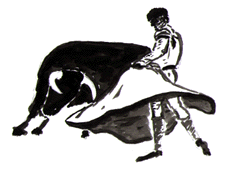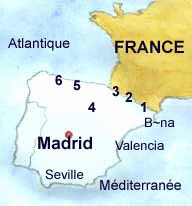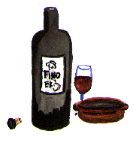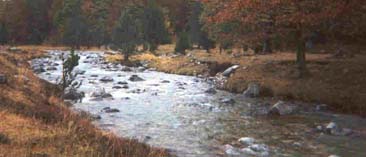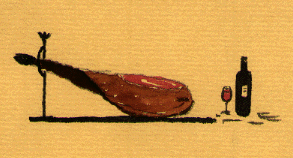|
Travels with a
fly rod in the Pyrenees ...
- by Mark. D. Williams -
From an article published in The Angling Report of September
2001
*
The Angling
Report newsletter -serving the angler who travels- is an
outstanding American monthly fishing publication. It recommends and
turns thumbsdown on specific fishing lodges... critiques good and bad
guides... and tells you honestly whether you should or not pay good
money to visit a given area. Each month are coming news and where-to-go
information on the American West, Central and South America, The
Caribbean, Alaska and Canada. It also provides an excellent coverage on
fishing in the rest of the world - namely Africa, Russia / CIS, Europe
and more.
Flyfishing the Western Pyrenees
Angling for Brown Trout in Spain and France
By Mark D. Williams (copyright Mark D. Williams)
These are among the wildest, most scenic trout streams in Europe,
flowing under the sentry of the imposing peaks of the Pyrenees, set
amongst the first race to populate Europe, the hospitable but
mysterious Basques in a land so medieval, sheep-herding is still a
viable and common way to make a living. This is the land of which
Hemingway wrote in his classics, The Sun Also Rises and Death in the
Afternoon, the land where both Papa and his characters drank hearty red
wine, ran with the bulls in Pamplona, watched bullfights in ancient
Roman arenas and caught brown trout in the still unspoiled Irati River.
Navarra. Aragon. Bearn. These are former homes of Kings. In the French
foothills, just out of the Pyrenees, flow the Gave d'Oloron and Gave de
Pau and they hold big salmon and sea-run trout as well as brown trout
(although the salmon populations have seriously declined). The wine
country of Bordeaux lie to the north, and pilgrimage destination of
Lourdes sits in its foothills. Castles stand as silent fortresses atop
dizzying cliffs, guarding against ancient memories of attacks. The
Pyrenees remind me of the lay of the land in southwestern Colorado and
northern New Mexico with its arid, high desert foothills approaching
the mighty mountain range from the Spanish side, and the craggy alpine
peaks and valleys, waterfalls and rushing streams of the highlands
across the French border. The Basques call these primeval mountains,
Auniak. More than most any other area of Europe, flyfishing for trout
in this isolated pocket of Old World Europe doesn't cost an arm and a
leg. Much of the best water is public and the stretches that are not
can be fished for a small fee. Licenses to fish public water are
inexpensive (although confusing). Fishing the Pyrenees is less about
the size of the fish or the deciphering the prevailing hatch and more
about the substance of flyfishing in a land that hasn't changed since
knights rode about on horseback. To be sure, anglers will find the
freestone streams full of chunky browns, some fairly sizeable. And the
scenery is as magnificent as any in western Europe. But you fish here
for the ambience and history and culture and food. Digs are cheap
despite the high quality of lodging and the incredible regional cuisine
these hotels serve (often as part of the price of the hotel). Most nice
hotels run from 30 to 70 dollars a night double occupancy so dinner for
two is often worth what you're paying for the room alone. The Pyrenees
are only a one-and-a-half hour flight from Paris or Madrid so any
angler on a trip with the wife or family, or on business would find
getting to these ancient mountains extremely do-able.
My wife Amy and I visited the Pyrenees in June for two weeks
of fishing for brown trout (with the perfunctory adjunct side trips of
shopping and general tourism thrown in for good measure). We knew we
wanted to get a full sampling of the range of rivers in this area,
ranging from tiny high country streams to the big, slow lowland rivers.
The choices, even for a small section of the northern Pyrenees, are
overwhelming, so much so, we chose to hire the services of
www.gourmetfly.com to help us set up our trip. In my searches on the
internet for info about this area, I found this website had the most
data on flyfishing Spain and France of any free site out there. We
began by emailing the propietor/flyfishing guide/travel guru named Nick
and describing our basic travel desires. We knew we could spend about
$3000 on the whole shebang, from airline tickets to food to hotels to
guides to car rental. We wrote Nick that we wanted to fish small and
big and everything in between. We wanted to see the countryside, stay
in clean hotels. Amy wanted to make sure all of our rooms had a private
bathroom and toilet. I just wanted to be close to the river. Nick was
honest with us about some of our plans. He would tell us "this drive is
too long from that town to fish those two rivers in a day. No, you
don't want to take the train from Paris. You won't have time to drive
into Pamplona." That sort of thing. Don't think you can look at the map
and see 60 miles from one town to the next and believe you can get
there in an hour. You can't. There are no straight roads in the
Pyrenees. And when you factor in your lazy lunch at a sidewalk
café and a two-hour four-course meal, you won't have time but to
fish one river a day anyhow.
Nick and www.gourmetfly.com
provide info about which roads to take, where to turn, how to find the
hotel, the best restaurants in the town. He secures rooms at these
hotels. Nick secures fishing
licenses which are waiting for you at your hotel.
He provides a detailed itinerary with directions and instructions of
the rivers you will fish, tells you about local and regional history in
the area, suggests techniques and fly patterns and equipment --- he
even provides adjunct trips in case the weather is bad or the water is
high. We paid a little over 300 bucks American to get a two-week
itinerary, secured hotel rooms, twenty-plus pages of detailed fishing
information, history and culture. He even set up our itinerary with
plenty of alternate plans, hoping to fish as many as 10 rivers, but
with runoff and season rains, knowing that we might only fish 4 or 5.
Our trip had us circling from Biarritz to Pau to Ainsa to Sarvise to
Garralda to Navarrenx and back to Biarritz. We could not have done the
trip without his preparation.
France, Valle d'Campan / The Adour River and
Tributaries
Our first destination was to fish a high altitude stream for wild
browns about an hour-and-a-half east from our hotel located near Pau (a
very English city of some 100,000, the largest of the northern French
Pyrenean towns). We got lost going through Lourdes because we stopped
in the centre ville
to get some breakfast and couldn't figure out how to get to the other
side of town. There are few stop signs and no stop lights in this part
of the world. They use circles where four streets or more intersect and
curve around to reach the other section of the same street. And these
guys drive fast ! Keep your eyes peeled. Being lost in Lourdes and
driving still too slowly like an American tourist, we no doubt nearly
caused several wrecks but we finally struggled out of town and made it
up the scenic valley to the village of La Seoube and three hours after
we left our hotel, we pulled into the front of the hotel. We were told
the drive was about an hour and a half but 1) I was not used to driving
under Indy 500 conditions with the narrow roads and hectic
traffic 2) everything just takes longer in Spain and France. You end up
planning around it. We met up with our guide Mariano and immediately
hit it off with him. He is exactly what we needed for our first foray
into the French high country. Spanish-born but having lived his life in
this valley in France, and having watched enough American television,
his three languages allowed him to converse with us and anyone else we
met. He spoke Spanish (with an Andalusian accent which was fun for me,
because I have a Tex-Mex Spanish accent when I speak Spanish). We
communicated easily but he always made a point to help Amy
understand what we were saying. He is witty, too. And he spoke enough
English to bridge the gap. We spent til late evening with him fishing
the Adour, the Adour-Payolle, and a secret perfect stream I am not
allowed to name or he gets to kill me. The rivers were knee-deep,
cobble-bottomed, clearing from runoff and cold. We could see trout
holding but they were picky and the casts needed to be precise. The
hatches were sparse that day although Mariano told us that the mayfly
and caddis hatch throughout the warm months. We caught many browns,
nothing of great size, on mostly generic nymphs on droppers below dry
flies but we were amazed at the incredible scenery, reminiscent of many
spots we fish in the West. We decided that it was in fact more
beautiful because it is in Europe (this is where we fell in love with
countryside Europe by the way). Mariano took us to a bar/cafe at the
top of the mountain (so it seemed) for a very Pyrennees-style lunch of
cured canard breast, cured ham, olives, and a meal of ternera and
frites (rare steak and French fries). Despite the pool of sangre, the
meat was delicious and we savored the lunch and the fishing. Mariano
was the perfect fishing and travel guide, helping us understand the
cultural differences and helping us decipher the clear streams and wild
browns. The cost for two people to fish 8-12 hours with Mariano on
these public and beautiful streams is about $150 American (but you must
pay now in Euros and the currency exchange varies but it was roughly
153 euros). A two-week fishing license costs about 23 euros (roughly
$25 per person). Mariano doesn't provide lunch or flies but does have
rods and waders you can use. He also guides for trout in northern
Spain. Guides in France and Spain tend to fish with you which to some,
might be distracting. Just let them know ahead of time. We wanted
Mariano to fish with us so we could watch his techniques, watch where
he put the fly. And you won't start fishing at daybreak rather in
the late morning --- but you may not finish until just before dark.
Aragon, Spain / Rios Cinca y Ara
We had car trouble that next day and Budget Rental Europe earned no
points in my mind, with their quarrelsome, inffective manner. We limped
across the border, going back up the Valle d'Campan, and after being
stranded in the mountains a couple of hours, we stayed in Bielsa that
next night (nicer than most American hotels and it has a great view
over the river and cost only $30 for the night). We took off the next
morning, apprehensive about traveling with a troubled car through some
wild country. We stopped in for a couple of hours, an 11th century
fairy-tale fortress standing guard on the promontory village
overlooking the junction of the Rio Cinca and Rio Ara. This is a
must-stop side trip to get the real feel of Old World Europe. The Rio
Cinca was brown-tinged from runoff and rain. The lower part of the town
holds little interest so by pass it. We stopped on the way to get our
licenses for Aragon and Spain as well as secure a permit to fish
private club water. The drive along the Rio Ara is as scenic as any we
have in the United States. High mountains, frontier ghost-towns,
thousand-year old churches. The river was high and blue, too high from
recent rains and runoff to fish comfortably.
We stopped a couple of times to take pictures but left the car running
(not taking any chances). We reached our hotel by early afternoon,
enough time to get settled in and take the rods to the river. But the
river was so high and the sky so blue and the day so hot, the trout
were uncooperative. We caught two small trout the entire day. The river
has few riffles, mostly chutes and runs and pocket water with some huge
pools. We saw some big browns holding in the middle of the river, trout
that might have gone close to 2-4 pounds, but too far away to
comfortably reach with our casts since the river was up and fast. But
we enjoyed the beauty of it all and walked all the way to the village
and back. We would like to return to fish the Ara with a guide and when
it's not so high. We stayed at the charming and folksy hotel, a
magnificent building with an interesting history (rebuilt from photos
after it was destroyed by the government in the Spanish Civil
War). The food we took each night was delicious but I liked the house
red wine better than Amy did. (The best wine we had on the trip was in
the Bearn country in France, an inexpensive local red but we also liked
the Jurançon, a sweet white, very much.) Like most of the hotels
on our trip, you eat at their restaurant for two reasons. First, there
are few if any other choices in towns so small the sheep outnumber the
residents. Two, the food is as good as anything you'll get in bigger
European cities. A double room cost us 6,500 pesetas per night or
around 35 dollars American. A fishing license for Rio Ara was 1,287
pesetas each (less than 10 bucks).
Navarra, Spain / Rio Irati, Rio Urrobi
We drove through Jaca the next morning, through all kinds of
different-looking countryside and enjoyed the often desolate vistas. We
also took a side trip into Pamplona. That was a mistake. We had no idea
traffic and congestion was so bad in that town (now a city I guess with
200,000 people or more). We couldn't find any parking anywhere (we were
not yet accustomed to the European way of parking on sidewalks or
anywhere that is open). We left without stopping and took N135
northeastward to N140 into Navarra. Along the way, we began to see
Pelegrinos, sometimes walking 3 abreast in the road. Bicyclists,
sometimes very old men, were also performing the pilgrimage. An amazing
site to see so many dedicated worshippers. We zipped right past them,
in and out of them zooming like a good European --- I was beginning to
drive and think European at this point. We had eaten food that we
thought we would never eat --- we had duck breast, we ate goat cheese
and cheesecake made from goat cheese, we tasted foie gras, we ate boar
venison, we ate ternera so rare it mooed at me. But we loved it all.
Even with all our difficulties, only halfway through our trip, we were
already claiming this as our best trip ever. We made it into our hotel,
having seen the houses change to the Basque style for over an hour.
This hotel became our favorite of the trip, and Angel and Noelia, both
Basques, our favorite hosts. Every man born into Angel's family since
his great-grandfather and his brothers had been born in this house. The
couple worked so hard to please us, communicated so eagerly, spent time
teaching us about their culture, that they were the perfect hosts. We
fished the upper reaches of the Rio the first evening after a lunch of
tapas (chorizo sandwiches and frites). We caught many plump 6-10 inch
brown trout and I had one heavy trout probably 13 or so inches take my
fly but break off in the submerged limbs. We sight-casted to these
trout and they would hit any perfect presentation. Any drag or shadow
or ripple of water from wading and the trout would shoot off for cover.
We took the traditional late Spanish dinner and I enjoyed more ternera
but especially enjoyed the verdura soup (a thick vegetable soup) and
roasted red peppers appetizer. When I got a phone call early on the
morning of the 9th, I thought it would be my mother since it was the
morning of my 41st birthday and she always calls me. But it was my
travel guide Nick checking up on us and our trip, making sure
everything was going well. A double room cost us 8,500 pesetas per
night, around 45 dollars per night with tax. Our bill for two nights of
sleep, two breakfasts and two full dinners added up to around $180
American. By midmorning, after eating breakfast in a panaderia (Spanish
for bakery) in Auritz, we fished the tiny meadow stream, Rio Urrobi at
the intersection of N135 and N140. The trout are very very small but as
we fished up to the ivy-covered ancient bridge, the water got deeper
and the fish got bigger. I caught one fat little trout about 10 inches,
the biggest we caught there.
Gray duns and Red Quills were hatching everywhere and the water was
spotted with rises. After a lunch in Roncesvalle, at a castle not far
from where the great warrior Roland had fallen, we hit the middle
sections of the Rio Irati. We drove past the cottage where Ernest
Hemingway used to stay when he fished the river. We found two different
ways to the river near, two small villages, complete with white square
houses and colorfully-painted shutters with Basque names over the
doors. One of our highlights in Navarra was seeing the beret-wearing
sheepherder drive his herd through main street and into a pen in the
middle of the afternoon. You just don't see that sort of thing
everyday. The river has a tea-colored tint to it but is so very clear,
with such long, still pools, that the fish were awfully skittish and it
took patience and long leaders and skillful wading to even draw a rise.
We moved up to the runs and ends of pools and did better but with such
a clear sky, fishing was difficult. Around 4 or 5, the clouds moved in,
(some of that rain that had been in the area but had yet to hit us),
and the insects started hatching (an amazing variety of stoneflies,
mayflies and even some caddis), and we started landing more and more
trout. These were nice-sized, heavy-bodied fish, stuffed from eating
insects, especially the 1 ½-inch long golden stoneflies that
were landing erratically everywhere. Just before dark, we drove back up
to the upper reaches of the Rio Irati and descended into the canyon
where I had missed the fat fish the previous day --- he nudged two
offerings and when I put on the golden Stimulator, he took it and dove
for cover under a rock then threw the fly when he ran upstream through
a waterfall. He must have been 15 inches and for such small water, he
was gargantuan. I will catch and land him next year. A long dinner of
filete de ternera (and for Amy trucha y jamon), a great bottle of
Navarran wine, some brandy and the strongest coffee in the world, and
the great day was complete.
Itinerary:
Food barrier: The food is different. If you are squeamish
or finicky or stuck on fast food, get over it. The meat choices are
about the same at all the eateries: lamb, salmon, steak, fish (hake and
trout the most common) and duck. Appetizers run the gamut from frois
gras (enlarged goose liver) to olives. Breakfasts are light, usually a
croissant or bread or pastry with coffee and fresh-squeezed orange
juice. Lunches are also often light. But dinners are a different story.
In France, the restaurants we ate at usually didn't begin serving until
8 pm, and in Spain, even later. The meals consisted of several courses
and almost always included desserts. These dinners often last two hours
or more. Know that the coffee is not like American-style coffee and is
strong. Because there are no fast-food joints, we kept groceries with
us in the car.
Telephones, faxes, computers: We never had a phone in our
room except in Navarra. That would have made it difficult for someone
with a laptop in need of an internet fix. Public phones are far and few
between. We found one public phone in every town, usually near the
plaza. You will need a calling card for that country to make calls and
deciphering the numbering system to make a call is tougher than a
physics lesson. Leave your computer and cell phone and beeper at home.
Your American cell phone won't work here anyway and besides, you don't
need the bother. Remember, you're in Europe where everything takes
hours or days to get done. Relax.
Stores: Do you need band aids or shampoo or cough syrup or
batteries? Get'em in Paris or bring'em from home. There are few stores
that carry those types of things (except in the big towns like Pau and
Lourdes). You buy meat at the meat market, bread at the bakery, cheese
at the fromagerie.
Hotel quality: These are large old homes,
sometimes several hundred years old, converted to hotels. The rooms are
often oddly-shaped and have a strange assortment of period furniture.
The bathrooms in all of these hotels are very small (as are the
Europeans of this region we met). If you like hotels with personality,
rooms with character, then you will love staying in these hotels,
looking out shuttered windows, flinging them open each morning to see a
fog-covered field with a sheperd tending sheep, the mountains all
around you. If you like Paris or New York style quality, this may not
be your bag.
Driving in Europe: They don't drive on the 'wrong side of
the road'. That's Great Britain. But they do drive fast and pass a lot
and have no fear. We rented a compact car that was upgraded to a van,
an Opel SUV contraption, which was half van and half sports car. It
cost us about $300 unlimited for two weeks and got great gas mileage. I
mean diesel mileage. Traffic signage is usually clear but you have to
pay attention to the arrows.
Airfare, airports: We found round trip airfare in coach
from Dallas to Paris for about $400 each. The round trip fare from
Paris to Bayonne/Biarritz was about $200 apiece. The trip takes 9 hours
from Dallas to Paris but coming back fighting the wind, takes 11 hours.
The food and service on Air France does not compare to British Airways
in my opinion.
Currency: We didn't exchange enough of our traveler's
checks into local currency before we hit the road. Each town of any
size has a bank or a shop that converts currency but you have to find
the perfect hour when they are open each day. And the currency exchange
rates are not good. And we found out the hard way that some banks don't
work with American dollars or traveler's cheques, and are willing to
only change either pesetas or francs. The guides don't take credit
cards and most of the restaurants in these little towns don't either.
Runoff / Timing / Seasons: May and June are the time of
runoff in the Pyrenees but like the southern Rockies, you can always
find a stream just finishing runoff or in pre-runoff.
Guides: In these Pyrenees, don't expect the same services
you receive in the United States. You won't get lunch. You won't get
flies supplied. You also don't pay as much with most charging about 150
American dollars for one or two persons. Half day rates are usually
available. We found our guides to be knowledgeable, courteous,
friendly, eager to please, and excellent anglers, useful almost as much
as tour guides as fishing guides.
Language barrier: I speak Spanish fluently but neither
Amy nor I speak French. In Paris and Biarritz, this was not a problem.
In the French countryside, it was a humorous problem, nothing serious,
nothing that some hand gestures and patience couldn't solve.
Gear: Any travel rod less than a 6-weight will be fine. If
you fish the big rivers, like the Gave d'Pau and Gave d'Oloron, an 8-9
foot rod of 5 or 6-weight is ideal. For the smaller rivers, I recommend
a 7-8.5 foot rod for 3-5 weight outfit. Tippet equivalent in France
& Spain 9X= 0.08, 8X= 0.10, 7X =0.12, 6X= 0.14, 5X= 0.16, 4X= 0.18,
3X= 0.20 mm. It is usually expressed in 100's, ie: 0.14mm is said 14
centièmes (In French). I used 6X exclusively there. Wade wet or
wear lightweight waders but make sure to have felt soles. It doesn't
hurt to have a wading staff in these slippery streams.
|
